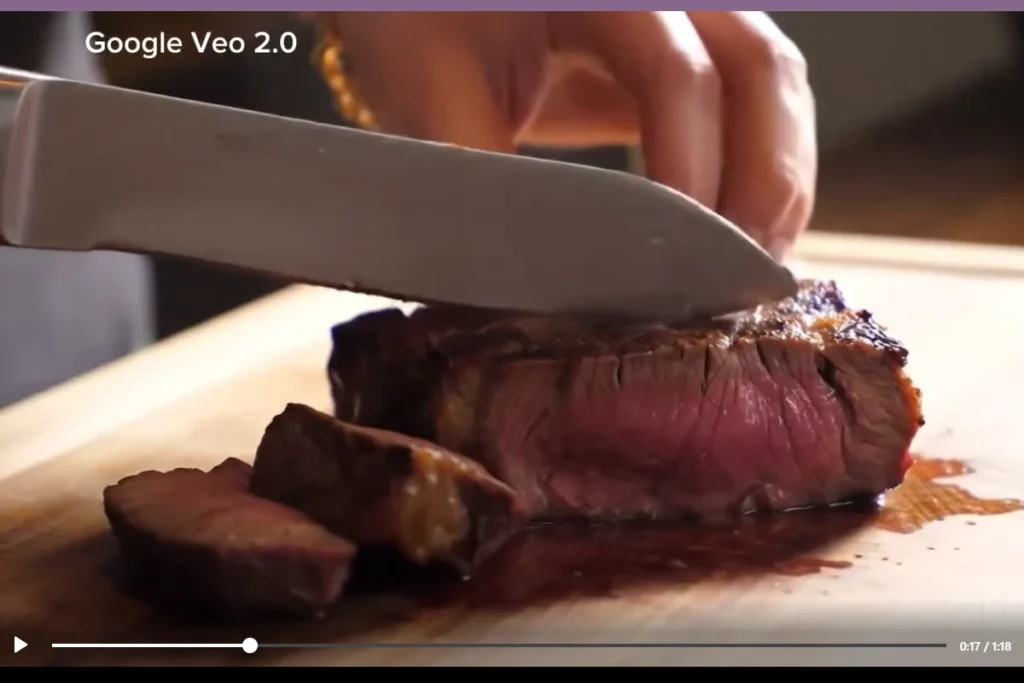A simple online video comparing how different AI systems handle the task of virtually slicing a steak has gone viral at an alarming rate. It provides a clear snapshot of the current state of AI video generation and reveals clear leaders in the field.
Google’s latest AI video creation tool, Veo 2, took center stage in this comparison. This video shows that Veo 2 significantly outperforms competitors, including OpenAI’s Sora, at understanding instructions and producing realistic output.
This competition highlights the power of Google’s generative AI technology in video production. Veo 2 demonstrates the ability to create high-quality, life-like videos from text prompts, demonstrating Google’s significant lead in AI-generated video content.
This comparison highlights the potential of Veo 2 to revolutionize content creation across various platforms. Specifically, YouTube Shorts will integrate this technology to make it easier for creators to generate high-quality backgrounds and short clips. This integration could change the way users interact with and create content on social media platforms.
You can watch the video on Reddit.
Or on Instagram here:
https://www.instagram.com/blizaine/reel/DDriUm0uqg8
Google’s advances in AI video generation go beyond Veo 2. The company also introduced Music AI Sandbox and Imagen 3, further expanding its suite of creative AI tools. These innovations place Google at the forefront of an AI-driven content creation revolution, giving users unprecedented capabilities in video and audio production.
Evaluate the realism of AI-generated videos
“Steak test” becomes a big boom
A recent video comparing different AI models that generate footage of steak slicing has gone viral, sparking a discussion about the rapid advances in AI video generation. This comparison highlights the huge differences in realism and overall quality between the various models.
Google’s Veo 2 stands out
Among the models compared, Google’s Veo 2 scores highly for its incredibly realistic output. The video produced by Veo 2 convincingly depicts the knife cutting the steak, the texture of the meat, and the subtle movements of the hands. Many viewers have noted the impressive level of detail and realism achieved by this model.
Performance comparison with other models
In contrast to Veo 2, other AI video generation models included in the comparison have received less positive feedback. Some models struggled to accurately represent the interaction between the knife and steak, resulting in unnatural or inconsistent movement. In some cases, it was not possible to satisfactorily capture the texture and appearance of the meat. One model also displayed excess steam coming from the steak, which detracted from the realism.
Factors that contributed to Google’s success
The Veo 2’s superior performance can be explained by several factors. Some speculate that Google’s access to vast amounts of video data, particularly from YouTube, plays a key role in training its models. Others point to breakthroughs in Google’s AI systems and the possibility of attracting top researchers from other companies. Whatever the reason, the Veo 2’s output represents a major step forward in AI video generation.
Comparison of AI video generation models (based on viral videos)
The importance of realistic video generation
The ability to generate realistic videos has a huge impact on a variety of fields such as entertainment, advertising, and training. As AI models continue to improve, we expect to see even more impressive and realistic video content produced by these technologies. The viral Steak Slice video serves as a compelling demonstration of this rapid progress, with Google’s Veo 2 currently leading the way.
Important points
Google’s Veo AI demonstrates advanced capabilities to generate realistic videos from text prompts YouTube Shorts will integrate Veo to enhance content creation options for users Google’s suite of AI tools, including Veo, enables the company to Establishing yourself as a leader in driven content creation
Google advances in generative AI for video creation
Google has made great strides in developing AI-powered video creation tools. The company’s latest innovation aims to revolutionize content creation for businesses and creators.
Evolving video models and quality improvements
Google’s new AI video model Veo 2 raises the bar for generated video technology. This advanced system can create high-quality videos from text prompts or still images. Veo 2 improves on its predecessor with improved visual fidelity and smoother movement.
The model’s capabilities extend to text-to-speech integration and AI avatar generation. These features allow you to create believable presenters and voiceovers in multiple languages.
Google also introduced Imagen 3, its most sophisticated text-to-image conversion model to date. This tool complements video creation by generating high-resolution still images that can be incorporated into video projects.
Generative AI tools for content creators and marketers
Google Vids, a new AI-powered video creation app, is now available to select Google Workspace customers. This tool allows businesses to quickly create professional-looking videos without the need for advanced editing skills.
Users can input text prompts to generate video content and streamline the production process. This app offers customization options for branding and styling.
Google’s VideoFX tools, powered by Veo 2 technology, offer experimental features for manipulating and enhancing your videos. These advances allow marketers to create engaging content more efficiently.
The company’s focus on AI-powered video creation tools is aimed at helping businesses cut through the noise in workplace communications and digital marketing.
Viral AI Steak Slice Video Comparison
AI-generated videos are becoming increasingly popular on social media, especially on platforms like YouTube Shorts and TikTok. AI steak slice comparisons have received a lot of attention and show the potential to quickly create visually impressive content. These tools, like Runway and Descript, allow content creators and marketers to seamlessly blend AI-generated footage with stock images and music to create professional-quality videos with minimal resources. Masu.
This technology increases engagement on short-form content platforms, allowing creators to focus on the storytelling rather than the technical aspects of production. Overall, AI video tools are transforming the content creation landscape and opening up niche market opportunities.



